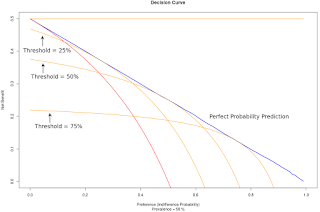Net.Benefit <- function(R, D, p.grid) { ## Purpose: Calculate Net Benefit for Decision Curve ## Arguments: ## R: Clinical Reference Standard (0 = Negative, 1 = Positive) ## D: Device Diagnostic Output (0 = Negative, 1 = Positive; OR D = Probability, 0 < D < 1) ## p.grid: The probability levels at which net benefits are to be calculated. ## Return: Net Benefits ## Author: Feiming Chen ## ________________________________________________ N <- length(R) # sample size Net.Benefit <- rep(0, length(p.grid)) for (i in seq_along(p.grid)) { p <- p.grid[i] N.TP <- sum( D > p & R == 1 ) N.FP <- sum( D > p & R == 0 ) Net.Benefit[i] <- (N.TP - N.FP * p / (1 - p)) / N } Net.Benefit } if (F) { # Unit Test D <- runif(100) R <- sapply(D, function(p) rbinom(1, size = 1, prob = p)) # perfect probability prediction p.grid <- seq(0, 0.99, 0.01) # Grid of indifference probabilities Net.Benefit(R, D, p.grid) } decision.curve <- function(R, D) { ## Purpose: Perform Decision Curve Analysis ## Arguments: ## R: Clinical Reference Standard (0 = Negative, 1 = Positive) ## D: Device Diagnostic Output (0 = Negative, 1 = Positive; OR D = Probability, 0 < D < 1) ## Return: Decision Curve ## Author: Feiming Chen ## ________________________________________________ N <- length(R) # sample size p.grid <- seq(0, 0.99, 0.01) # Grid of indifference probabilities NB <- Net.Benefit(R, D, p.grid) prevalence <- sum(R == 1) / N plot(p.grid, NB, type = "l", xlim = c(0, 1), ylim = c(0, prevalence), lwd = 2, col = "blue", main = "Decision Curve", xlab = "Preference (Indifference Probability)", ylab = "Net Benefit", sub = paste("Prevalence =", round(100*prevalence, 1), "%")) ## Intervention for all NB.all <- Net.Benefit(R, rep(1, N), p.grid) lines(p.grid, NB.all, type = "l", col = "red", lwd = 1.5) ## Perfect Binary Test NB.perfect.binary <- Net.Benefit(R, R, p.grid) lines(p.grid, NB.perfect.binary, type = "l", col = "orange", lwd = 1.5) } if (F) { # Unit Test D <- runif(100000) R <- sapply(D, function(p) rbinom(1, size = 1, prob = p)) # perfect probability prediction decision.curve(R, D) }if (F) { # Simulation Code ## Perfect Probability Prediction (D0) D <- runif(100000) R <- sapply(D, function(p) rbinom(1, size = 1, prob = p)) decision.curve(R, D) ## Binary test (B1) with 50% sensitivity and 100% specificity. p.grid <- seq(0, 0.99, 0.01) # Grid of indifference probabilities B1 <- sapply(R, function(x) ifelse(x == 1, rbinom(1, 1, 0.5), 0)) NB.high.spec <- Net.Benefit(R, B1, p.grid) lines(p.grid, NB.high.spec, type = "l", col = "orange", lwd = 1.5) ## Binary test (B2) with 100% sensitivity and 50% specificity. B2 <- sapply(R, function(x) ifelse(x == 0, rbinom(1, 1, 0.5), 1)) NB.high.sens <- Net.Benefit(R, B2, p.grid) lines(p.grid, NB.high.sens, type = "l", col = "orange", lwd = 1.5) ## Random prediction model (D1) for: $D \sim \mbox{Uniform}(0, 1), R \sim \mbox{Bernoulli}(0.5)$ NB.random <- Net.Benefit(rbinom(100000, 1, 0.5), D, p.grid) lines(p.grid, NB.random, type = "l", col = "red", lwd = 1.5) }


